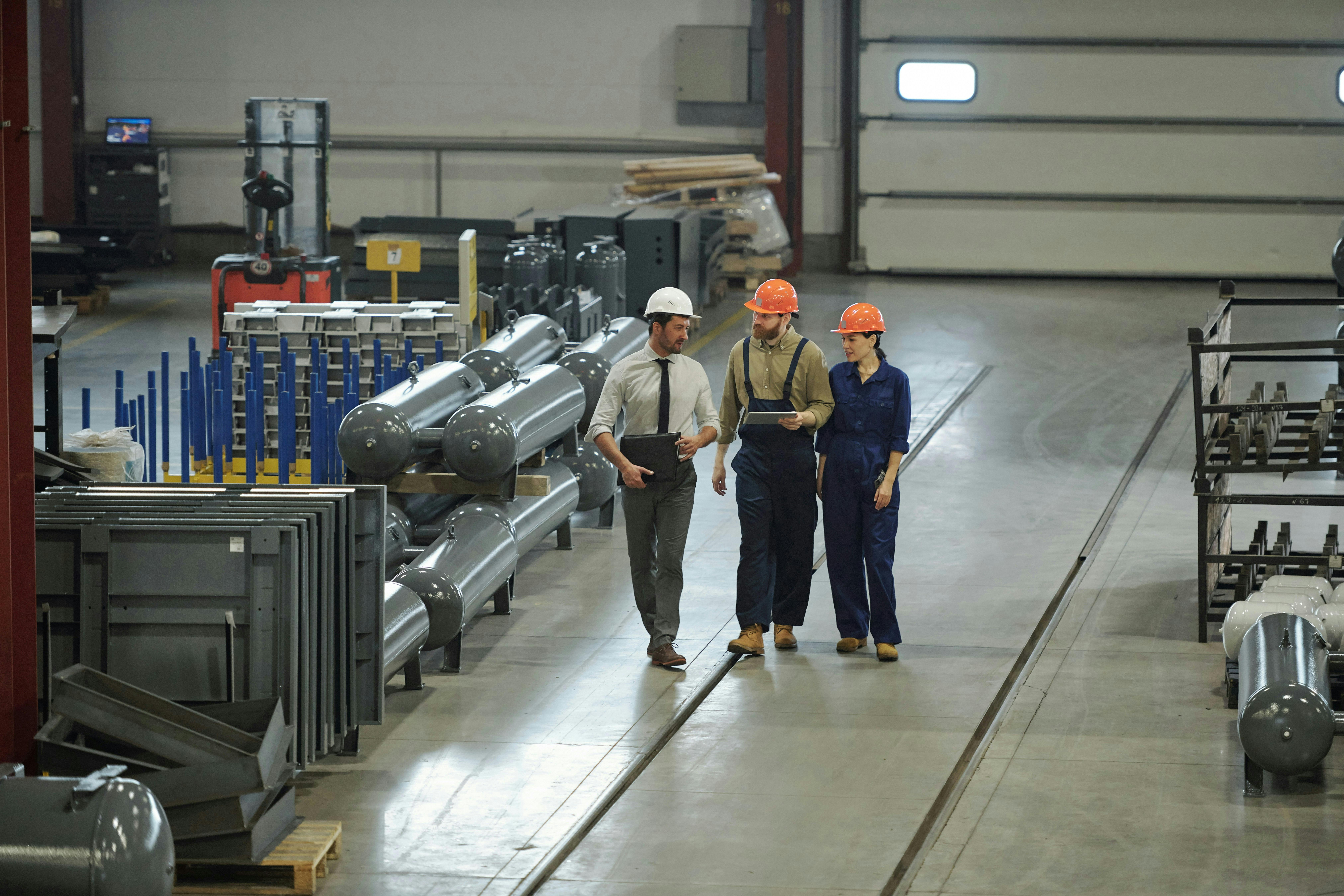Getting Buy-In for Predictive Maintenance: What to Show Your Site Leader
Jun 20, 2025
Predictive Maintenance
Introduction
Getting buy-in for predictive maintenance (PdM) software is no longer just a technical challenge—it’s a leadership one. Whether you're a maintenance manager, reliability engineer, or operations lead, the first barrier to improving reliability is rarely the technology itself. It’s convincing your site leader that it’s worth the time, budget, and change effort.
In agri-food manufacturing—where margins are tight, hygiene standards are rigorous, and production targets are non-negotiable—introducing a new reliability initiative can feel risky. Even if the value is clear to you, many site leaders default to what’s familiar. They’ve seen plenty of flashy systems that promised to save the world and quietly disappeared six months later.
That’s why this guide exists. You already know that predictive maintenance can reduce unplanned downtime, stretch your labour hours further, and extend equipment life. But knowing that isn’t enough. To make it happen, you need your site leader to sign off on it.
This article gives you the tools to make that happen—step by step. We'll cover how to translate technical benefits into site-level ROI, address objections before they surface, and frame your pitch in a way that speaks directly to what your leader cares about most.
Whether you’re working at a dairy, bakery, seafood processor, beverage line, or any other high-throughput manufacturing site, this guide will show you how to move your PdM initiative from a good idea to a live project.
The Problem: Why Good Ideas Get Rejected
One of the most frustrating realities in maintenance and reliability is that great ideas don’t always get approved. You can bring a solution that promises real savings, improved safety, and operational resilience—only to be met with blank stares or budget roadblocks.
Why?
Because site leaders aren’t just weighing whether it’s a good idea. They’re weighing the risk.
Even when PdM makes logical sense, it represents change. And change—especially involving hardware, IT, or new processes—can feel like a disruption to site priorities. Leaders are dealing with staffing gaps, production audits, inventory constraints, and safety obligations. If you’re asking them to add “new software deployment” to that mix, the bar for saying yes is high.
Here are the top reasons good predictive maintenance proposals get rejected:
- Past failures: “We tried vibration sensors before. Nothing came of it.”
- Budget fear: “We don’t have spare funds this quarter.”
- Capacity concerns: “We don’t have anyone to run this.”
- IT resistance: “Security will never allow this.”
- Scepticism: “Will this actually deliver results?”
None of these are technical barriers. They’re leadership concerns. They come from a lack of certainty that this initiative will truly deliver.
To win your leader over, your pitch must do one thing: de-risk the decision.
That means simplifying the deployment, anchoring benefits to operational KPIs, and demonstrating that PdM is not a distraction—it’s an enabler.
Insight: What Site Leaders Actually Care About
Let’s get tactical. To win support, you need to align with the priorities that matter to your site leader. These aren’t abstract metrics—they’re the KPIs your leader is judged on, day in and day out.
1. Production Uptime
This is the number one concern at most sites. Downtime equals lost output, missed orders, and inefficient labour. If PdM helps prevent even one major failure per quarter, it supports this KPI directly.
2. Cost Avoidance
Many sites run on tight budgets. Leaders won’t approve new tools unless they believe those tools will prevent bigger expenses—whether from emergency callouts, rushed freight, or equipment replacement.
3. Compliance and Food Safety
In food and beverage plants, compliance is king. If equipment failures risk product loss, contamination, or audit non-conformance, PdM becomes a food safety tool—not just a reliability one.
4. Labour Efficiency
Site leaders know their teams are stretched thin. If PdM replaces unnecessary inspections or time-based maintenance with targeted, condition-based work, it supports lean staffing without sacrificing reliability.
5. Scalability
Can the solution expand to more assets, lines, or sites? A good pilot might win a quick yes, but a strategic leader also wants to know it can be rolled out broadly without IT headaches.
6. Visibility and Accountability
Dashboards, reports, alerts—they matter. Site leaders want to show results to their peers, managers, and group ops. A PdM platform that offers clear reporting builds internal credibility.
If your pitch to your site leader starts with a discussion of AI models, FFT curves, or sampling rates—you’ve already lost them. Speak their language. Connect PdM benefits to the exact things they’re measured on.

Step 1: Start With the Pain
Every successful pitch begins with a clear articulation of the problem. And not just any problem—the one that your site leader already feels in their gut.
You’re not introducing a new initiative because it’s trendy. You’re solving something costly, frustrating, and persistent. You’re bringing a solution to a known pain. The more clearly and specifically you can define that pain, the easier it becomes to build urgency.
Ask Yourself (and Your Data):
- What was the most expensive unplanned downtime event in the last 6 months?
- How many production hours did we lose due to mechanical failure last quarter?
- Which assets fail most frequently? Are they monitored?
- How many hours do we spend on time-based PMs that rarely result in intervention?
- Do we have a clear log of failures that could have been predicted?
Now pull that together into a narrative:
“In February, the CIP pump on Line 2 failed without warning. The site lost 6 hours of production, 18 pallets of product were scrapped, and the emergency repair callout cost $4,800. Total cost? $42,000—on one machine, in one day.”
Or:
“We inspect 80 motors monthly. Over the last quarter, 92% of those inspections found no actionable issues. That’s over 120 hours of labour being spent reactively—not strategically.”
By surfacing the real, measurable cost of the current state, you create a baseline that PdM can improve upon.
And you establish a powerful theme for your proposal: status quo is not neutral—it’s expensive.
Step 2: Reframe Predictive Maintenance as Cost Avoidance
Once the pain is on the table, your next move is to reframe PdM as a cost avoidance strategy, not an added cost.
Site leaders don’t have spare budget lying around. What they do have is pressure to hit output targets without surprise costs derailing the week. Predictive maintenance helps them meet those targets—by reducing the most expensive, most disruptive events they face.
Here’s how to frame the financial case:
- Avoiding even one major failure often offsets the entire year’s PdM cost
- Replacing calendar-based PMs with condition-based tasks reduces wasted labour
- Early warnings allow cheaper, planned interventions—not last-minute panic repairs
Put hard numbers on the table. For example:
“A single gearbox failure on our bagging line costs ~$35,000. A predictive maintenance pilot on that line would cost ~$12,500 for 25 assets for the full year. Preventing just one failure offsets the entire investment and delivers a 180% ROI.”
Or:
“With PdM, we can reduce unnecessary PMs by 50–70%. For our team, that’s at least 100 hours a month redirected from routine checks to high-value tasks.”
By changing the conversation from “how much will this cost?” to “how much will this save us?”, you help your leader make a smart investment—not approve a new expense.
Step 3: Use Realistic Examples
Once the pain is defined and the savings opportunity is clear, it’s time to bring the solution to life with realistic examples. These are your proof points. And while they don’t need to be from your exact plant, they should feel familiar and credible.
Here are three powerful (fictional but realistic) examples from Factory AI deployments in agri-food sites:
🧀 Example 1: Dairy Plant – Prevented $60K Motor Failure
A regional dairy processor in Victoria installed Factory AI on five key pasteurisation motors. Within 10 days, an anomaly alert flagged a rising bearing fault in one of the motors.
The site scheduled a bearing replacement during the next CIP window. Total repair cost: $1,750.
Had the failure gone unnoticed, the motor would have failed mid-run, leading to 8 hours of downtime, emergency labour, and discarded product. Estimated cost of failure: over $60,000.
The early warning transformed what would’ve been a crisis into a routine intervention. And it paid for the PdM deployment in under two weeks.
🐟 Example 2: Seafood Plant – Compressor Saved, Compliance Maintained
A seafood processing plant in northern Tasmania installed predictive monitoring on their blast freezer compressors. One unit showed elevated vibration linked to internal imbalance.
Factory AI’s AI-based fault classification confirmed the issue and triggered an alert. The compressor was serviced during the weekend. No disruption. No product loss.
If the compressor had failed mid-week, the site risked temperature deviation, food safety exposure, and a full production stop. Downtime and spoilage would’ve cost ~$85,000.
Beyond financial savings, the site passed its next HACCP audit with flagged improvements in proactive asset management.

🍞 Example 3: Bakery Site – 27% Reduction in Maintenance Hours
A frozen baked goods site wanted to reduce the load on their 4-person maintenance team.
They used Factory AI to monitor all 18 motors on their proofing and mixing lines. Previously, the team completed calendar-based PMs on all 18 assets every 30 days—many of which never needed intervention.
After six months of PdM, they adjusted their strategy based on asset condition data. Maintenance hours dropped by 27%. Breakdown incidents fell by 42%.
No new headcount. No extra tools. Just better targeting of time and resources.
Each example follows the same structure: a specific asset, a problem caught early, an avoided failure, and measurable impact.
When presenting these stories to your site leader, anchor them to the types of machines, costs, and workflows they already understand. The closer the analogy, the more convincing the story.
Step 4: Address the Top Objections Proactively
Every seasoned maintenance leader knows the objections are coming. But the key to a successful pitch isn’t waiting to be challenged—it’s answering the questions before they’re asked.
Here are the most common pushbacks and how to disarm them:

Objection 1: “We tried this before and it didn’t work.”
✅ Response: Many manufacturers have tried PdM in the past—but the tech was immature, the process manual, or the insights unclear. Factory AI is different: always-on, real-time, and automated. There’s no need for vibration expertise or manual trend analysis. You don’t need a reliability engineer to interpret the data—alerts are plain-language and actionable.
Example: “You’ll receive a mobile alert that says: ‘Elevated bearing wear detected – Mixer Motor 14 – Fault expected in ~14 days’. That’s something the team can act on immediately.”
Objection 2: “We don’t have the people to manage another system.”
✅ Response: Factory AI isn’t just another system. It replaces routine inspections and eliminates the guesswork. It reduces the number of wrench-hours—not adds to them. Many sites use it to offset headcount shortages.
You’re not asking for more labour. You’re asking to spend less time fighting fires.
Objection 3: “We already have a CMMS—why do we need this?”
✅ Response: A CMMS tracks what happened. Factory AI tells you what’s about to happen. The two work together: PdM triggers work orders inside your CMMS, making your workflows more intelligent.
Example: “Imagine getting a fault alert on Fan 12, then seeing a work order automatically generated in your CMMS for inspection and repair. That’s real integration.”
Objection 4: “Our equipment is too old or too simple for this.”
✅ Response: Factory AI works on everything from 20-year-old conveyors to brand-new pumps. It doesn’t require smart motors or OEM integration. If it rotates, vibrates, or moves—it can be monitored.
We’ve seen major wins on legacy chillers, fans, augers, and mixers.
Objection 5: “What happens after the pilot—are we locked in?”
✅ Response: No lock-in. You only pay for the sensors you keep active. If the pilot doesn’t deliver, you walk away. Most sites expand because they want to—not because they have to.
Factory AI’s model is built on transparency, not long-term contracts.
Objection 6: “We don’t think we have that much downtime to justify it.”
✅ Response: Many teams underestimate how much downtime they’ve normalised. Start by listing your last 3 failures. Add up the cost of callouts, lost production, and delays. That alone usually justifies a PdM pilot.
Factory AI also includes a downtime cost calculator to help you quantify your own numbers.
Step 5: Break It Down Into a Small, Safe Pilot
Pitching a full site rollout is a recipe for delay. The most effective strategy is to suggest a pilot project that’s small, fast, and measurable.

The Ideal Pilot:
- 25 - 50 assets (e.g. a single line, compressor room, or utility area)
- Install in under 30 minutes per asset
- No dependency on plant Wi-Fi
- No need for IT support or network integration
- Insights delivered in the first 48 hours
- Full ROI tracking during the pilot window
This takes the decision from high-stakes transformation to low-risk experiment. Most site leaders are far more comfortable saying yes to a test.
You can frame it like this:
“We’ll trial it on 20 motors on Line 3. If we prevent one failure, it pays for itself. If we don’t see value in the first month, we can stop without cost escalation.”
Better yet, let them know you’ve done the prep:
- Which assets to monitor
- What installation looks like
- When you could start
- What success would look like
- How to roll back if needed
A confident, low-risk plan makes it easy to say yes.
Step 6: Bring the Demo to Life
Some leaders need to see it to believe it. A 20-minute demo can make the difference between hesitation and buy-in.
Here’s what you can show in a Factory AI demo:
- Live dashboard with real asset data
- Fault alerts showing severity, failure mode, and urgency
- Reporting tools with downtime savings calculations
- Deployment photos from hygiene-sensitive environments (e.g. dairy, seafood, frozen lines)
- Mobile alerts to show how it fits existing workflows
If your site leader can’t attend, ask for a demo recording or walk them through the highlights yourself.
You can book a live walkthrough at: https://f7i.ai/demo
Even better, pair the demo with your pilot plan. Show them exactly what they’d be approving, how quickly it gets results, and what data they’ll see at the end.
Step 7: Put It In Their Language (Not Yours)
As a reliability professional, it’s easy to fall into technical jargon—vibration thresholds, AI models, sampling rates, spectral patterns. But when speaking to a site leader, the language must shift from technical detail to operational value.
If your pitch contains more engineering acronyms than business outcomes, it won’t land.
Translate It Like This:
What You Want to Say --> What Your Leader Needs to Hear
“AI flags early-stage faults using FFT analysis.” -->
“We’ll know about problems 2–3 weeks before failure.”
“We measure vibration velocity in mm/s RMS.” -->
“We can catch wear before it causes unplanned stops.”
“We use fault classifiers trained on 10 million failure modes.” -->
“We don’t need vibration experts to interpret the data.”
“Condition-based PMs reduce unnecessary labour.” -->
“We’ll stop wasting hours on equipment that doesn’t need attention.”
“Cloud-based deployment avoids local network integration.” -->
“No need for IT or Wi-Fi—install and go.”
Put yourself in their shoes. Your site leader is likely juggling a dozen pressures—staffing, throughput, compliance, customer orders. When you bring predictive maintenance to the table, make it clear how it makes their life easier, not more complex.
If you want a good test, try pitching the idea to a production supervisor or scheduler first. If they understand it and see the benefit, you’ve got the language right.

Step 8: Show the Long-Term Opportunity
Getting buy-in for a pilot is step one—but the real value comes when your site leader sees PdM not just as a fix, but as a strategy.
Once the pilot is up and running, and you’ve got your first win, you can start planting the seeds for long-term impact. You’re not just buying sensors—you’re transforming your site’s approach to reliability.
Long-Term Strategic Wins to Highlight:
- Full line coverage: After the pilot, scale to all critical assets on a production line. Monitor everything from conveyors to chillers.
- Multi-site rollout: Once the first site sees ROI, replicate the model across other locations.
- CMMS integration: Create a closed loop—fault alert triggers task → task resolution feeds reliability data → insight drives continuous improvement.
- Total labour optimisation: As time-based PMs shrink, free up staff for project work, root cause analysis, or cross-training.
- Asset lifecycle extension: Fewer breakdowns and better timing of maintenance can add years to major assets.
- Energy optimisation: Early fault detection reduces overloading, vibration, and energy waste.
- Audit readiness: Every intervention is logged. Every fault is time-stamped. PdM becomes a paper trail for compliance bodies like HACCP, SQF, and BRCGS.
Let your leader see the next level of maturity. Don’t push too fast—but start building the case for a reliability-driven culture, not just a reliability tool.
Step 9: Build a Shared Success Plan
Once interest is high, your next move is to build a success plan together. Involve your leader in defining what “good looks like.”
This might include:
- Assets to monitor in the pilot
- Baseline downtime or failure rates
- Definition of success (e.g. 1 major failure prevented)
- Pilot timeframe (e.g. 3 months)
- Reporting cadence (e.g. weekly email summary, 1-page monthly dashboard)
- Post-pilot review meeting
By involving your leader, you increase emotional buy-in. It’s no longer your project. It’s our project.
And if the pilot succeeds, they’re not just a sponsor—they’re a champion for broader rollout.
Step 10: Make It Easy to Say Yes
Last but not least: remove the friction. Make it as easy as possible for your site leader to say yes.
Provide them with:
- A one-page summary of PdM benefits
- Example ROI calculations from similar sites
- A visual of what installation looks like (especially in food-safe zones)
- Contact details for the demo or pilot proposal
- Answers to anticipated IT/security questions
- Clarity on pricing, duration, and off-ramp
You’re not just pitching a technology—you’re building confidence.
“We’ll start with 15 sensors, no IT setup, no disruption, and a one-month pilot. If it works, we scale. If not, we walk away. We’ve already got support from Tim in engineering. Ready to give it a try?”
Make saying yes feel like a smart, safe, low-stakes move.
Part 5: Tools, Templates, and Talking Points – Your Buy-In Toolkit
Sometimes, the biggest barrier to buy-in isn’t your site leader—it’s simply finding the right words, documents, or proof to move the conversation forward. That’s where a tactical toolkit can help.
This final section gives you practical resources and templates to bring everything in this article to life. Use them in your next internal pitch, proposal, or meeting.
1. Quick Pitch Template
Use this 3-line script when you have 60 seconds to get your site leader’s attention:
“We’re spending too much time and money on breakdowns we could’ve seen coming. I’ve found a PdM system that takes 30 minutes per asset to set up, doesn’t need Wi-Fi or IT, and can prevent $50K+ failures. We can try it on just 10 assets to start—want to see what it looks like?”
This template is built for hallway conversations or post-shift discussions when time is short but interest is high.
2. 1-Page Pilot Proposal
A site leader won’t read a 14-slide deck—but they will skim a clear, focused one-pager.
Include:
- Purpose of the pilot
- Number and location of assets to monitor
- Installation process (brief, food-safe, no IT required)
- Duration (typically 4–8 weeks)
- Success criteria (e.g. alerts caught, breakdowns avoided, downtime saved)
- Cost (flat-rate or sponsored pilot offer)
- Next steps and decision point
If you’d like, I can help you draft a customised pilot proposal based on your specific site.
3. ROI Calculator Walkthrough
Use a simple ROI framework that looks like this:
Cost per major equipment failure : $30,000
Number of failures in past 6 months : 3
Pilot cost (25 assets) : $10,000
Failure prevented threshold : 1
Show your leader: “If this prevents just one of our usual breakdowns, we’re already ahead. If it prevents two, we’ve tripled our money.”
You can download calculators from Factory AI or customise a spreadsheet with your own data.
4. IT & Security Cheat Sheet
If your site’s IT team is often a gatekeeper, prepare to answer their common concerns.
Factory AI’s modem-based approach is designed specifically for IT-light deployments. Here’s how to frame it:
- No dependency on factory network or Wi-Fi
- Data transmitted via 4G modem with secure, encrypted protocol
- Minimal bandwidth usage
- No SCADA or PLC integration required
- Deployed at ASX- and NASDAQ-listed sites with existing IT approvals
Having a one-pager that explains this earns immediate credibility with both site leadership and IT.
5. Slide Deck for Team Briefings
Once buy-in is secured, you’ll need to bring other teams along for the journey—like operators, sparkies, or mechanical techs.
Create a short slide deck that includes:
- What PdM is (and isn’t)
- What machines are being monitored
- What an alert looks like
- Who gets notified and how
- What’s expected from the team (e.g. confirm alert, book task, respond)
This avoids confusion and helps the pilot land smoothly. If you're presenting to trades or techs, keep it visual and skip the buzzwords.
6. FAQ Answer Bank
Prepare for internal meetings by having short, confident answers ready to go. Here are some common ones:
- Q: What if it doesn’t find anything?
A: Then we’ve confirmed those assets are running well—and avoided unnecessary PMs. - Q: Can we use our existing sensors?
A: Yes. Factory AI is sensor-agnostic. We can use what we have or bundle new sensors in. - Q: What’s the cost after the pilot?
A: $500 per asset per year—no lock-in, scalable by asset or line. - Q: How quickly do we see value?
A: Most sites see meaningful alerts and ROI within the first 2–3 weeks.
7. Comparison Chart (Internal Use)
If you're fielding questions like “How’s this different from what we tried before?” or “Why not use something cheaper?”, prepare a quick comparison of the top contenders.
Include rows like:
- Setup time
- Need for Wi-Fi/IT
- Cost per asset
- Condition detection types
- Alert clarity
- Usability by trades
- Integration with CMMS
Factory AI should lead in 4–5 categories, but show a balanced table. You’ll win more trust by being honest about the trade-offs.
8. “What Success Looks Like” Email Template
Once the pilot is approved and underway, keep your site leader in the loop with a monthly check-in email like:
Subject: Predictive Maintenance Pilot – Month 1 Update
Body:
Hi [Name],
Quick update on our PdM pilot using Factory AI:
- Assets covered: 20 (incl. Mixer Line, CIP pumps)
- Insights generated: 3 early fault alerts
- Actions taken: 1 bearing change, 1 fan belt tension fix
- Estimated downtime avoided: 11 hours
- Next steps: Assess results by [date] and plan potential rollout to Line 2
Happy to run through it in person if helpful. Appreciate your ongoing support.
Cheers,
[Your Name]
A well-structured update like this shows traction and transparency—critical for scaling PdM across the site.
Final Thought: Build a Movement, Not Just a Case
Getting buy-in for predictive maintenance isn’t about convincing one person. It’s about changing how your site thinks about maintenance altogether.
It starts with one pilot. One early win. One confident leader who says, “Let’s give it a go.”
But it grows when trades see it reducing their fire drills. When schedulers see fewer delays. When production sees smoother weeks. When auditors see better records. And when leadership sees fewer costly surprises.
You’re not just bringing in new software. You’re reshaping how your team maintains the machinery that keeps your product, your brand, and your promises running.
That’s a mission worth leading.
Ready to start?
👉 Book a demo with Factory AI now and get your toolkit sent to your inbox.
